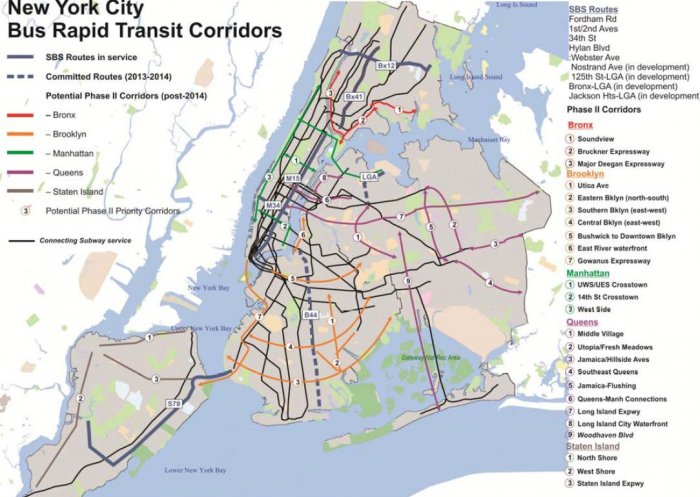
Pratt Center
Bus Rapid Transit Rolls: Pratt Center vision informs agency studies and a City Council bill

In 2007, Pratt Center and its partners in Communities United for Transportation Equity (COMMUTE!) were the only New York City groups talking about the potential of Bus Rapid Transit to address the mobility needs of underserved communities. Inspired by a visit to Bogotá, Colombia and the experience of riding TransMilenio, Pratt Center staff and allies confronted the dismal reality faced by poor and working-class commuters back at home. Our research showed that over 750,000 New Yorkers traveled 60 minutes or more to work – each way – and that two thirds of them were heading to jobs paying $35,000 or less per year. Geospatial mapping and analysis showed why: skyrocketing housing costs are pushing working-class New Yorkers outward – to neighborhoods where the nearest subway line might be a long, slow bus ride away. Jobs are moving out too – from manufacturing, distribution, and construction to retail, health care, and other services, low- and mid-wage workers are more and more likely to work outside of the Manhattan Central Business District, in clusters that are also poorly connected to transit. Pratt Center’s Transportation Equity Atlas mapped racial and economic disparities in transit access among New York’s neighborhoods.
But at that time, discussions of transit expansion were dominated by proponents of rail mega-projects that would cost billions of dollars and do more to leverage real estate development than to get New Yorkers to work. Pratt Center and COMMUTE! saw transit as an equity issue, and mobility as a human right. We drafted a vision of a citywide Bus Rapid Transit network, with off-board fare collection, dedicated lanes, and traffic-signal prioritization that would cross boroughs and bridges and enable high-performing buses to quickly connect hard-to-reach neighborhoods and workplaces.
In 2008, New York City’s Department of Transportation and MTA / New York City Transit launched Select Bus Service, incorporating key BRT features, on the Bx12 route in the Bronx. Pratt Center’s analysis and advocacy helped spur the agencies to move beyond their initial 5-route pilot to consider a more comprehensive approach. DOT and MTA’s 2009 BRT Phase 2 Studyvalidated Pratt Center’s approach, looking at underserved areas and difficult connections, and identifying priority corridors.
The success of additional SBS routes in Manhattan, Staten Island, and the Bronx have shown that even the modest investments needed to create SBS delivered real reductions in travel times, along with improved reliability and growth in ridership. Pratt Center has also supported effective engagement of communities in SBS planning, helping to maximize local benefits and minimize conflicts over parking and loading along the B44 Nostrand Avenue corridor in Brooklyn, set to launch SBS service later this year.
In July 2013, the MTA unveiled its own more expansive BRT vision, proposing up to 25 new routes, in addition to those already in place and committed. It’s exciting to see that New York City and New York State are aligned in their commitment to BRT expansion – and gratifying to note the resemblance of their plans to Pratt Center’s 2007 network vision map. A bill introduced on July 24 by New York City Councilmember Brad Lander is meant to ensure that BRT’s newfound momentum is maintained into the next administration. It requires NYCDOT to engage communities in developing a comprehensive vision, and to commit to realizing that vision within ten years.
Pratt Center applauds all of these developments, and calls on MTA and DOT to go faster, wider, and deeper – to build on the studies already completed and accelerate BRT planning and implementation in partnership with local communities- AND to realize BRT’s potential by building routes that cross bridges and link boroughs. More than ever in the aftermath of Hurricane Sandy, Bus Rapid Transit needs to fulfill its potential as a high-performing “third mode,” filling gaps and connecting New Yorkers to opportunity.